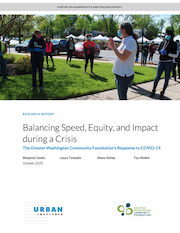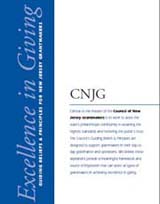Site Search
- resource provided by the Forum Network Knowledgebase.
Search Tip: Search with " " to find exact matches.
Community foundations are beginning to deepen and shift how they work, adopting an anchor mission that seeks to fully deploy all resources to build community wealth. Moving into territory relatively uncharted for community foundations, they are taking up impact investing and economic development — some in advanced ways, others with small steps. This report offers an overview of how 30 representative community foundations — including The Seattle Foundation, the Vermont Community Foundation, and the Greater Cincinnati Foundation — are working toward adopting this new anchor mission.
This Democracy Collaborative report was written by Marjorie Kelly, Senior Fellow and Director of Special Projects and Violeta Duncan, Community Development Associate.

The COVID-19 public health and economic crisis has changed our world as we know it. As employers moved to remote work, schools shifted to distance learning, and businesses closed completely, it became clear that the impact on residents, nonprofits, and businesses was far greater than anyone could have ever imagined.
In response to the growing and evolving needs of our region, the Greater Washington Community Foundation established the COVID-19 Emergency Response Fund to raise and rapidly deploy funding to local nonprofits providing food, shelter, educational supports, and other critical services.
From the beginning our goal was clear: to address the immediate needs and reach adversely affected communities, particularly low-income households and communities of color. We know all too well that in a crisis like this, these marginalized communities are hit the hardest, and often take the longest to recover.
In times of crises, The Community Foundation is our region’s philanthropic first responder, bringing together individuals and families, philanthropic peers, corporate partners, and local government advisors to address community issues. Building on our rich history of emergency response work, we grounded our COVID-19 response efforts in a similar coordinated approach.
This report chronicles the steps taken, under immense pressure, to develop a coordinated emergency response effort to support a broad range of needs across the region. Once again this effort has demonstrated that working in partnership and close collaboration with our philanthropic peers and local government advisors is an effective way to manage a response to both urgent and longer-term needs.
Sample disaster preparedness and recovery plans for foundations.

This includes insights and tips related to board governance, legal compliance, grantee communications, fiscal responsibility, public disclosure, and many other key areas of foundation governance and operations. It is intended to serve as a practical resource to assist foundations in their grantmaking.
CNJG is pleased to offer this series of webinars to our members, hosted by our partners at the Center for Disaster Philanthropy.
With COVID-19 there seem to be more questions than answers, particularly for funders who want to respond effectively and efficiently. This series of seven webinars will bring expert panelists together to address some of the most pressing issues, including getting money out the door quickly, supporting vulnerable populations and managing other disasters in the midst of the pandemic.
Join the Center for Disaster Philanthropy for one or multiple webinars to gain a better perspective on the role of philanthropy in COVID-19 response and recovery.
Cost: Free for CNJG members and Nonmember Grantmakers
CNJG thanks the Center for Disaster Philanthropy for hosting this series.
Past Webinars in this Series:
April 14: Making Effective Rapid Response Grants
April 28: Managing Multiple Disasters Amid the Pandemic
May 12: Place-based Grantmakers and Investing in Local Communities
May 26: How Philanthropy Can Stand Up for Vulnerable Populations
June 9: Grantmaking to Support Children and Older Adults
June 23: Managing a Global Response
Alexis Bivens, Vice President of Strategic Initiatives and Managing Director of the Supporting Organizing Work Funders Collaborative, Connecticut Council on Philanthropy, presents the process and progress of how an affinity group transformed into a funders collaborative, how it was resourced, and challenges along the way.

Developed in partnership with United Philanthropy Forum and Northern California Grantmakers, this guide shares seven practices and 12 tools for Philanthropy-Serving Organizations who seek effective ways to mobilize resources to sustain their organization’s work. The guide features perspectives from dozens of leaders of national and regional PSOs and examples from our work with these organizations. Much of the content is based on conversations and strategy work with PSO leaders, staff and board members.
This weekly conference call series welcomed New Jersey-based grantmakers along with national funders and provided an opportunity for grantmakers to hear from a wide range of experts in the field of disaster philanthropy. This series started on November 5, 2012, one week after Sandy struck New Jersey, and continued through March 25, 2013. The written summaries of each recording are listed below.
Sample board committee descriptions, including roles and responsibilities of committee members
Philanthropic organizations of all shapes and sizes are well positioned to support Communities for a Lifetime (CfaL). This issue brief explores four roles for philanthropy in advancing CfaL work.
Philanthropy can be defined in many ways. The word comes from the Greek, meaning "love for humanity." Modern definitions include the concept of voluntary giving by an individual or group to promote the common good and improve the quality of life.
Here in the United States, the term "philanthropy" is also used to describe the granting of money to nonprofit organizations by foundations and corporations. This type of giving is often called organized philanthropy or grantmaking.
This popular, fast-paced video offers a realistic — and often humorous — glimpse of how the public views philanthropy, using a series of "people in the street" interviews shot in the Twin Cities plus interviews with local donors. Discover the true, and often not so true, meaning of philanthropy.
Co-produced by the Minnesota Council on Foundations, The Minneapolis Foundation and the Minnesota Community Foundation and The Saint Paul Foundation.
M&T Bank has donated $75,000 in seed money to help the Center for Urban Entrepreneurship and Economic Development at Rutgers University launch a new fund to help Black entrepreneurs recover from the effects of the pandemic.
CUEED, based at the Rutgers Business School in Newark, will leverage the money from M&T to raise additional funding from other private and philanthropic sources. The center’s goal is to raise $250,000 to pilot its NJ BEST Patient Capital Fund, which will make low-cost, non-dilutive capital, recoverable grants of $25,000 to $50,000 available to selected Black-owned High-Impact Vital Enterprises — retail and service businesses essential to the viability of their communities.
Tom Comiskey, M&T Bank president for New Jersey, said the bank was excited to contribute to such a worthy aim.
“The pandemic has exacerbated challenges for Black entrepreneurs, making it increasingly difficult to secure capital for their businesses,” he said. “Essential to the foundation of New Jersey’s economy, M&T Bank is proud to support these business owners through the NJ BEST Patient Capital Fund.”
Welcome to the Council of New Jersey Grantmakers’ Foundation Funding Map, where members have free access to accurate, up-to-date grantmaking data critical to smart, strategic giving that makes the biggest impact.
The data shown on the map is from CNJG member and non-member foundations, corporate giving programs and others that have submitted their grants data through this Get on the Map! Campaign. The greater the number of funders that submit their data, using the template, the more complete this picture of how funds are distributed in New Jersey will be.
The FirstEnergy Foundation has granted two New Jersey nonprofits with $20,000 "Gifts of the Season," aiding in their mission to make lives brighter within the Jersey Central Power & Light (JCP&L) service area.
Cornerstone Family Programs, based in JCP&L's northern New Jersey region, and the Boys & Girls Clubs of Monmouth County, based in the central New Jersey region, both offer afterschool programs that focus on providing safe, empowering environments for local students.
"We're proud to support these organizations because their missions align with our commitment to a diverse, equitable and inclusive workplace where everyone feels valued, included and respected," said Lorna Wisham, president of the FirstEnergy Foundation. "The winners were chosen by FirstEnergy External Affairs employees who identified organizations in their local areas that do extraordinary work to strengthen the community and enhance the lives of vulnerable and underserved populations."

